Cross switch: purpose and device + connection diagram and installation
An electrical crossover switch is a device designed for use as part of electrical communication circuits.In particular, this class of devices is actively used when there is a need to organize control of light sources from different points. As a rule, the scheme involves the implementation of this device as an additional component to existing pass-through switches.
In this article we will look at the design and electrical circuit of the device itself, as well as connection features in various options. We will supplement the material with visual diagrams, photos and a video on self-assembly.
The content of the article:
Cross Switch Design
The device itself for inversion switching of power lines is simple. However, due to the multi-point circuitry characteristic of such devices, implementation difficulties can become real. Therefore, it is logical to consider the design of the device, as well as the connection diagrams.
The purpose of the communicator is obvious - connecting electrical circuits for household (commercial) purposes, where the voltage level does not exceed 250 volts. The standard design of the devices is designed for operation inside dry, warm rooms that meet the established protection class standard (IP20).
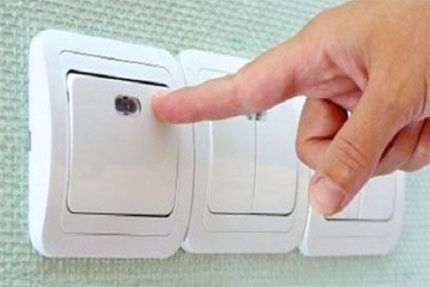
The installation of cross switches is carried out in the traditional way (similar to installation of a conventional switch light) with fastening the mounting box with screws, or internal installation is done with fastening the base to the wall with metal claws.
The body of the device is usually made of impact-resistant, non-flammable technopolymer. All structural parts for outdoor installation are resistant to ultraviolet radiation.

The mechanics of crossover switches for a current of 10A are equipped with quick-release contact groups. The mechanics of devices for a current of 16A have screw terminals. For ease of connection, the terminals (phase and neutral) are usually marked in different colors.
The switch terminals are designed for connecting conductors made using single-core or multi-core pulling technology. Cross-section of single-core conductors up to 2.5 mm2, stranded up to 4 mm2 (for 16A switches).
Electrical diagram of the device
If we consider the circuitry of cross-commutation devices, it should be noted that there are different designs of devices in terms of the number of contact groups. Simple and frequently used devices (single-key) have 2 floating (moving) contacts and 4 stable (fixed) contacts.
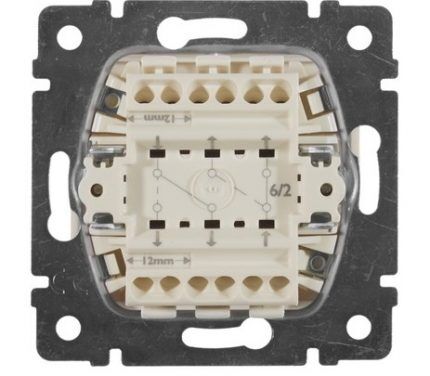
A more complex design of cross electrical switches (two-three-key designs) is already marked by the number of communication groups of up to 4-6 movable and up to 8-12 fixed contacts.
A distinctive feature of this type of devices is their “dependent” installation. In other words, cross-function switch designs are not installed without a pair of conventional switches.
That is why, when choosing an intermediate-acting device, you should pay attention to the number of working contacts. For intermediate switches, the number of working terminals is always at least four.
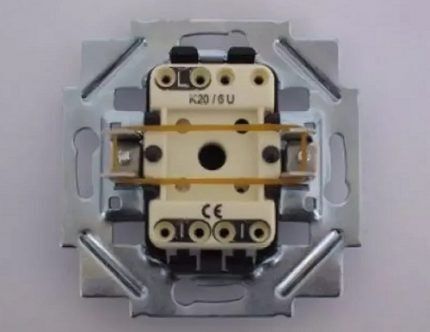
Thanks to the use of such devices, it becomes possible to create more flexible and user-friendly control circuits for lighting devices. The practice of using crossover devices as part of the infrastructure of industrial enterprises seems especially relevant.
Analysis of the schematic diagram of the device contact groups
If you take the classic (single-key) design of the device, produced, for example, by ABB, and turn the back side towards the user, approximately the following picture will open.
There are 4 pairs of terminals on the base board, each of which is marked with corresponding symbols - in this case, “arrows”. With a technical designation of this kind, the manufacturer provides the user with information about the correct connection of the device.
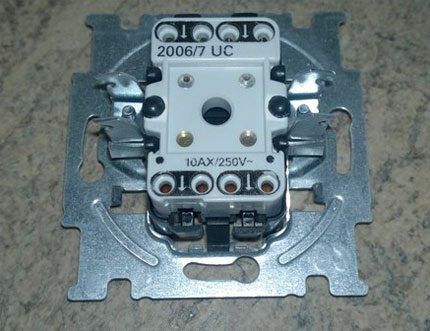
The incoming “arrows” indicate the general (changeover) contact group. Outgoing “arrows” mark the permanent contact group.
Schematically, the interaction of groups looks like in the following figure:
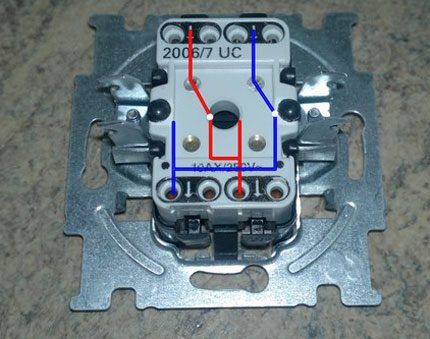
The terminals of the common (changeover) group of the contactor receive conductors from the first pass-through switchinvolved in the electrical circuit. Accordingly, conductors come out from the terminals of the second (permanent) group of the contactor, which are connected to pass-through switch number two, also prudently included in the circuit.
This is a classic variation using two through and one reversible devices.
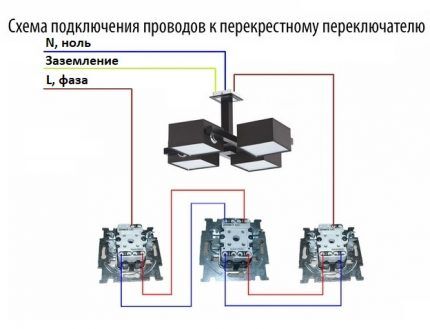
The device, designed to act as a reversible switch, can actually be used in one of two modes of switching an electrical circuit:
- Direct switching - an analogue of two pass-through devices.
- Cross-connection - The main purpose.
The configuration of the first option is essentially represented by the functionality of a direct connection with the ability to connect or disconnect.
The second configuration method (by installing jumpers) switches the device to operating mode using an inversion switching scheme.
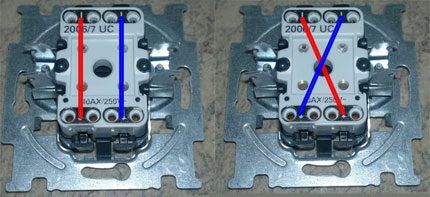
Thus, intermediate switches look functionally not just as switches for artificial light sources, but as switches of universal action.This factor expands the functionality of such devices and makes them convenient for use in different installation options.
Installation features and connection to the circuit
Inversion switches are installed using standard methods and techniques used in construction or electrical engineering. A convenient location for the device is preliminarily planned.
Then, taking into account the selected installation point and connection to the general electrical circuit, a wiring diagram is drawn for the intermediate switch and the pair of pass-through switches working with it.
As part of the project development procedure, the method of laying conductors is determined - surface or internal.

Taking into account the chosen method, the installation infrastructure is prepared (grooves, holes, fastening plugs, distribution boxes).
On the finished infrastructure, electrical wiring lines are drawn, wires are routed in distribution boxes, and the ends are brought out according to the diagram directly to connect to feed-through and intermediate switching devices.
Option #1 - nuances of connecting an intermediate device
The ends of the conductors (4 in total) brought out from the distribution box for connection to the intermediate switch must be prepared. In particular, insulation is removed in the section from the end along the wire to a length of approximately 10-12 mm.
By the way, many branded switches have a special marker on the chassis, which makes it easy to measure the required length of insulation stripping.

Now you need to identify the two conductors coming from the first pass-through switch installed in the circuit. Typically, all conductors are marked for ease of identification at the circuit wiring stage.
These two wires are connected to the two input terminals (in this case spring type) of the intermediate switching device. The remaining two are routed to the output terminals.
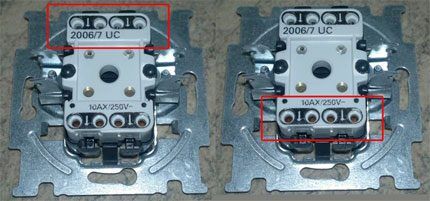
The chassis prepared in this way must be placed in place - installed inside construction socket box (for internal installation) or fix directly to the wall surface (external surface installation).
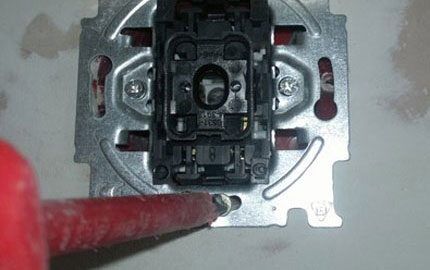
For indoor installations, the chassis is usually secured with spacer brackets or direct screw fasteners. When surface-mounting switches, direct screw mounting is traditionally used. Next, a frame is placed on the chassis and a key-cover is placed on the switch control lever.
Option #2 - circuit solutions for several devices
Intermediate installation switches are an integral component of circuit solutions where the principle of control from more than three points remote from one another is implemented.
Theoretically, there can be many such control points for artificial light sources. However, options for three or four, maximum five positions are practically implemented.Since with each new input of the device the overall wiring diagram becomes more complicated.
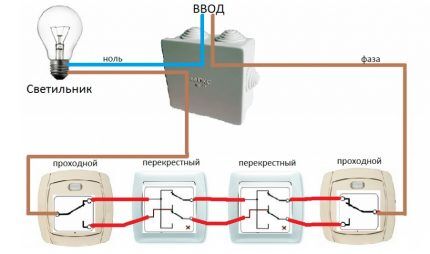
For example, we can consider four-position wiring, when the main components include two pass-through and two reversible switching devices. In such a scheme phase wire are connected to the moving contact of the pass-through switch.
When current is supplied to the network, it passes through the closed contact group of the pass-through type device and is supplied to the moving contact of one of the two cross switches.
Next, from the output terminal of the reversing device, the current flows to the second similar switch - to its movable contact group and through the output terminal it goes to the permanent contactor of the second pass-through switch.
If the changeover switch of this switch closes the circuit, current flows from its output to the light fixture. Through the filament of the lamp, the common circuit is closed to the zero bus. The lamp lamps are on. Now, if for the sake of experiment (and in practice too) you set any of the devices one by one to the “off” state, the lamps of the lamp will go out in each of the four cases.

But if you turn off all four at the same time, this peculiar communication group will simply switch to another switching line and the lamp lamps will remain energized - they will continue to burn.
An experiment with reversing devices clearly shows the functionality of the four-position crossover switch circuit. The lighting device can be controlled in any of the four positions.
Conclusions and useful video on the topic
Video material about the practice of controlling lighting devices using a crossover switch.
How to install and route wire lines from pass-through switches to crossover switches and how to connect devices:
The advantages of using PV are obvious, both from the point of view of user convenience and in terms of saving energy resources. That is why the considered electrical devices are quickly gaining popularity both in everyday life and in the industrial and economic sphere.
Would you like to supplement the above material with useful comments, connection diagrams or installation recommendations? Or maybe you noticed any inaccuracies or inconsistencies in this article? Please write your comments and advice in the comments block.




When we were doing the interior decoration of the house, the craftsmen suggested that we install cross and pass-through switches - to turn on the lights simultaneously on the stairwells of all floors. It turned out to be very convenient. Externally, such a switch is no different from a regular one, so our guests are very surprised when the lights come on on all floors. Still, few people know about such a feature.
The electrician who changed my electrical wiring during a major renovation suggested making pass-through switches in the hallway, I agreed. But when another team of craftsmen arrived, they mixed up the wires connecting the switches at two ends.Now these switches work according to a strange algorithm, which I still cannot understand: the light at the beginning of the corridor turns on only if the position of the switch at the end of the corridor is in the ON position, and if switched to the Off position, then the light is on The corridor doesn't light up at all. We'll have to redo everything, unfortunately. Are crossover switches and pass-through switches different concepts, or not?
It is surprising that the team of “masters” did not check the functionality of the network they entered.
A crossover (intermediate) switch and a pass-through switch are not the same thing. These switches have different wiring diagrams.
Good afternoon, Evgeniy. Crossovers and pass-throughs have different "internal circuits". By the way, the article contains diagrams - I have attached my screenshots for you. Of course, it will have to be redone. I advise you to think about introducing motion sensors, which will eliminate the need to cut routes for new wiring. On this site, the topic of sensors is covered in several articles. You can start with the material “How to connect a motion sensor to a light bulb.”